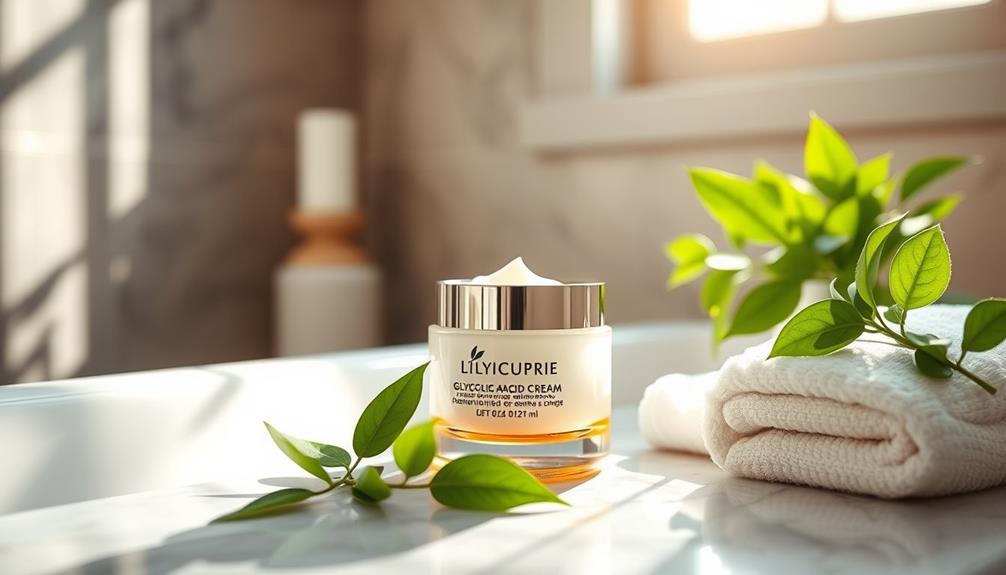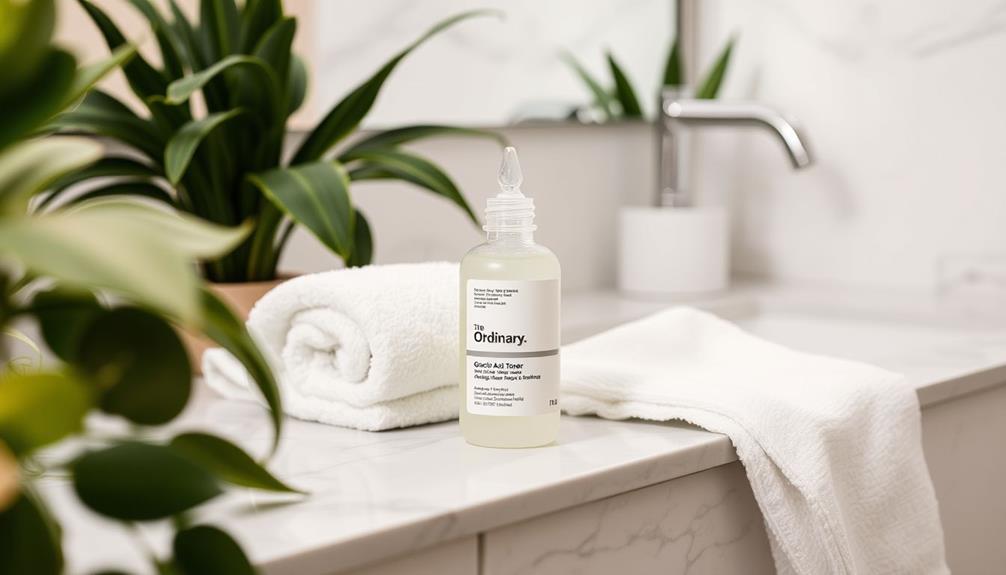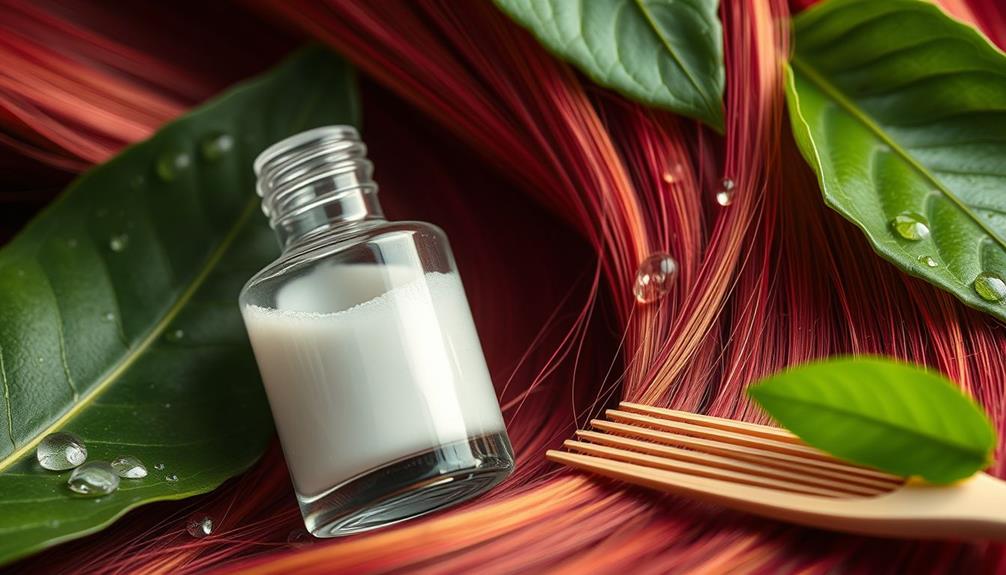Glycolic acid is a powerful tool in your acne-fighting arsenal. As an alpha hydroxy acid, it helps unclog pores and speeds up cell turnover, reducing breakouts. You can find it in various concentrations, typically ranging from 5% to 15%, making it suitable for different skin types. For best results, start slowly and always follow up with a moisturizer and sunscreen. It can even enhance the effectiveness of other acne treatments. If you're curious about maximizing its benefits and learning more about integrating it into your routine, there's plenty more to explore.
Key Takeaways
- Glycolic acid, an alpha hydroxy acid, exfoliates the skin, unclogs pores, and promotes cell turnover to reduce acne breakouts.
- It improves skin texture and diminishes acne scars by stimulating collagen production and enhancing overall skin appearance.
- Glycolic acid can be combined with other treatments, like salicylic acid, for targeted acne management and improved efficacy.
- Regular use of glycolic acid requires gradual introduction to minimize irritation, starting with lower concentrations for sensitive skin.
What Is Glycolic Acid?
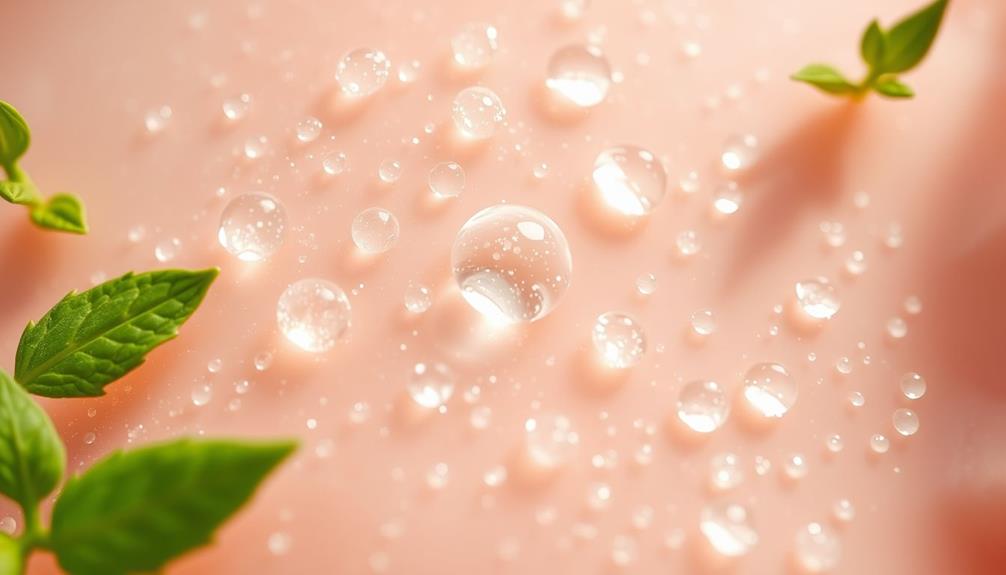
Glycolic acid is a powerful alpha hydroxy acid (AHA) derived from sugarcane that effectively exfoliates the skin.
As a chemical exfoliant, it helps you remove dead skin cells, unclog pores, and greatly improve skin texture. Its small molecular size allows glycolic acid to penetrate the skin easily, making it an excellent choice for various skin concerns, including acne treatment.
Additionally, incorporating complementary methods such as aromatherapy techniques can enhance overall skin health and well-being.
When you use glycolic acid, you may notice a reduction in acne lesions due to its ability to prevent the formation of comedones and decrease inflammation.
Concentrations of glycolic acid in products typically range from 5% to 50%. While lower concentrations can be found in over-the-counter products, higher concentrations are best used under professional supervision to guarantee safety and effectiveness.
Regular use of glycolic acid can lead to noticeable improvements in both acne and overall skin health.
By incorporating this powerful AHA into your skincare routine, you can experience smoother, clearer skin and a considerable enhancement in your skin's appearance.
Whether you're struggling with mild or moderate acne, glycolic acid can be a valuable ally in your skin care arsenal.
Benefits for Acne Treatment
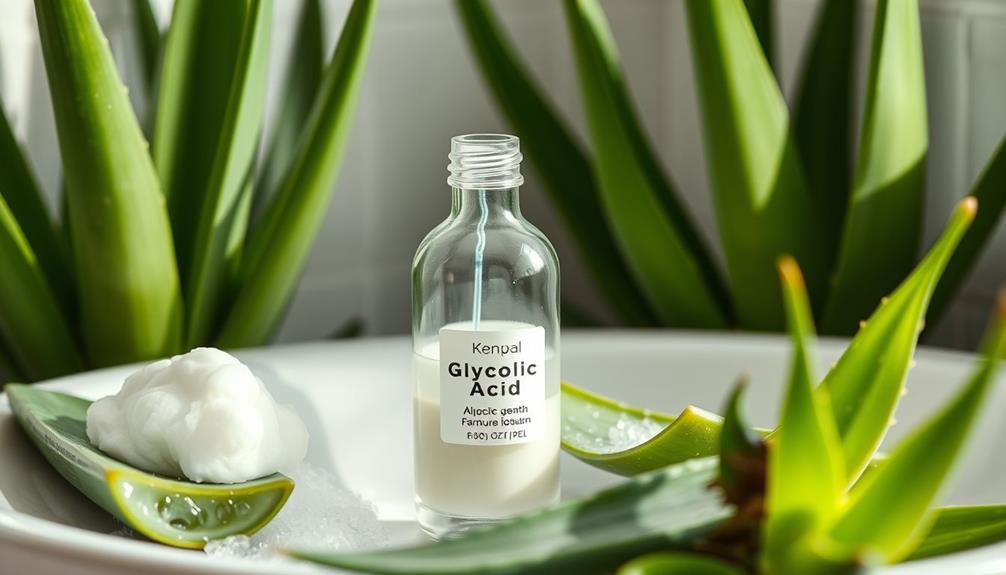
Incorporating glycolic acid into your skincare routine offers numerous benefits for treating acne, including promoting cell turnover and preventing clogged pores. This powerful alpha hydroxy acid is known for its exfoliating properties, making it an effective acne treatment for various skin types.
Additionally, maintaining a consistent skincare routine is essential for overall skin health, much like how safe second trimester workouts for pregnancy contribute to physical well-being. Here are some key benefits you'll experience:
- Enhanced Cell Turnover: Glycolic acid accelerates the shedding of dead skin cells, reducing the likelihood of comedones and breakouts.
- Improved Skin Texture: Regular use can smooth out uneven skin texture, making your skin feel softer and look healthier.
- Reduced Acne Scars: By stimulating collagen production, glycolic acid helps diminish the appearance of acne scars over time, leading to a more even complexion.
- Boosted Efficacy of Other Treatments: Using glycolic acid can enhance the absorption of other acne treatments, making them more effective in combating your acne.
With a concentration of 10-15%, glycolic acid is well-tolerated by many skin types, making it a safe and reliable option for managing acne. Embrace the transformative benefits of glycolic acid and watch your skin improve.
How to Use Glycolic Acid

To effectively use glycolic acid, start by applying it once or twice daily, based on your skin's tolerance.
It's essential to conduct a patch test to avoid any adverse reactions, especially if you have sensitive skin.
Consider incorporating soothing elements like essential oils, such as lavender oil, to help reduce potential irritation.
Also, be mindful of combining glycolic acid with other strong ingredients to prevent irritation and over-exfoliation.
Recommended Application Frequency
Start with a lower concentration of glycolic acid, using it once or twice a week to gauge your skin's tolerance before gradually increasing the frequency. Here are some tips to help you establish the right application frequency:
- Assess Tolerance: Begin with a 5-8% glycolic acid product, monitoring for any signs of irritation or discomfort.
- Daily Use: If your skin responds well, consider applying glycolic acid once daily in the evening, as this minimizes sun sensitivity.
- Moisturizer: Always follow up with a gentle, fragrance-free moisturizer to support your skin barrier after exfoliation.
- Sun Protection: Incorporate broad-spectrum sunscreen with SPF 30 or higher during the day to protect your skin from increased UV exposure.
Patch Testing Importance
Patch testing is essential for guaranteeing your skin can safely tolerate glycolic acid, especially if you have sensitive skin.
Start by applying a small amount of the glycolic acid product to a discreet area, such as your inner forearm. Monitor the area for 24 to 48 hours to check for any signs of irritation or adverse reactions, like redness or burning.
To gauge your skin tolerance, begin with lower concentrations of glycolic acid, typically between 5-8%. If you experience no adverse reactions during the patch test, you can gradually introduce glycolic acid into your skincare routine. Aim to apply it once or twice a week at first, allowing your skin time to adjust.
Always follow the manufacturer's instructions regarding application frequency and duration. This helps minimize the risk of irritation and guarantees safe usage.
Combining With Other Ingredients
When using glycolic acid, combining it with the right ingredients can enhance its effectiveness while keeping your skin healthy. Here are some effective combinations to evaluate:
- Glycolic Acid + Salicylic Acid: This duo targets acne by promoting exfoliation and controlling excess sebum, making it a powerful acne treatment.
- Lower Concentrations: Start with lower concentrations (5-8%) of glycolic acid to gauge your skin's tolerance before gradually increasing strength, especially when combining with other active ingredients.
- Glycolic Acid + Vitamin C: This combination provides antioxidant benefits, improving skin texture and brightness without compromising the effectiveness of either ingredient.
- Glycolic Acid + Moisturizing Agents: Adding ingredients like hyaluronic acid helps maintain skin hydration, countering dryness or irritation linked to chemical exfoliation.
Be cautious about using multiple exfoliating products containing glycolic acid and other AHAs or BHAs at the same time. This can lead to over-exfoliation and increased skin sensitivity.
Side Effects and Risks
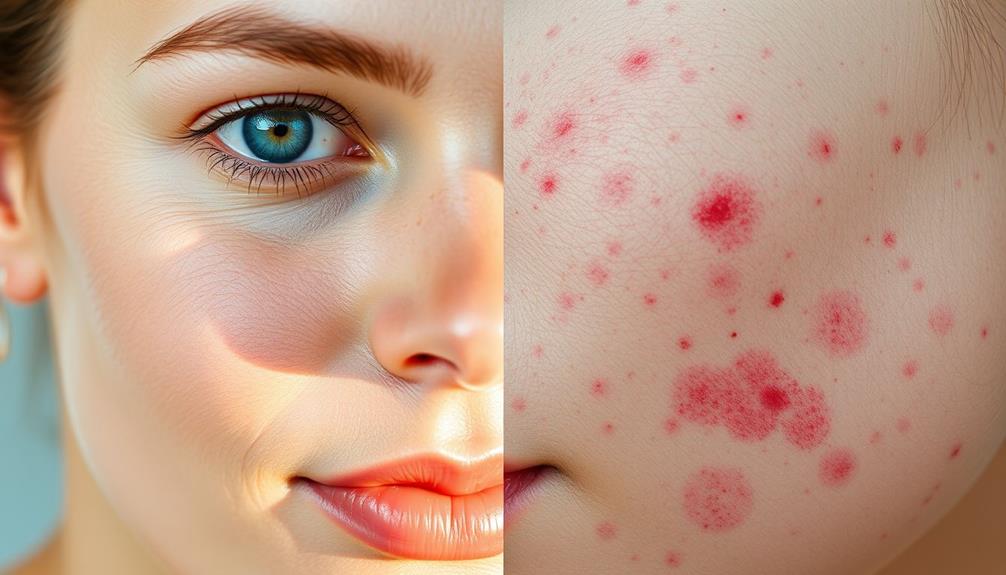
Using glycolic acid can lead to side effects like swelling, itching, and burning sensations, especially if you have dry or sensitive skin. These symptoms often indicate irritation, which can be exacerbated by higher concentrations of glycolic acid.
If you're considering using products with 30-40% concentrations, it's important to consult a dermatologist, as these levels should be administered under professional supervision.
In addition to irritation, glycolic acid can increase your skin's sensitivity to the sun, making daily application of broad-spectrum sunscreen with SPF 30 or higher necessary. This protects against sun damage and reduces the risk of hyperpigmentation, especially for those with darker skin tones who may experience heightened sensitivity and adverse reactions.
Overusing glycolic acid can worsen skin sensitivity, leading to more severe reactions. It's essential to monitor how your skin responds and adjust the frequency of use accordingly.
Always prioritize your skin's health and safety when incorporating glycolic acid into your acne treatment routine. If any severe side effects develop, consult your dermatologist immediately to reassess your approach.
Precautions for Sensitive Skin
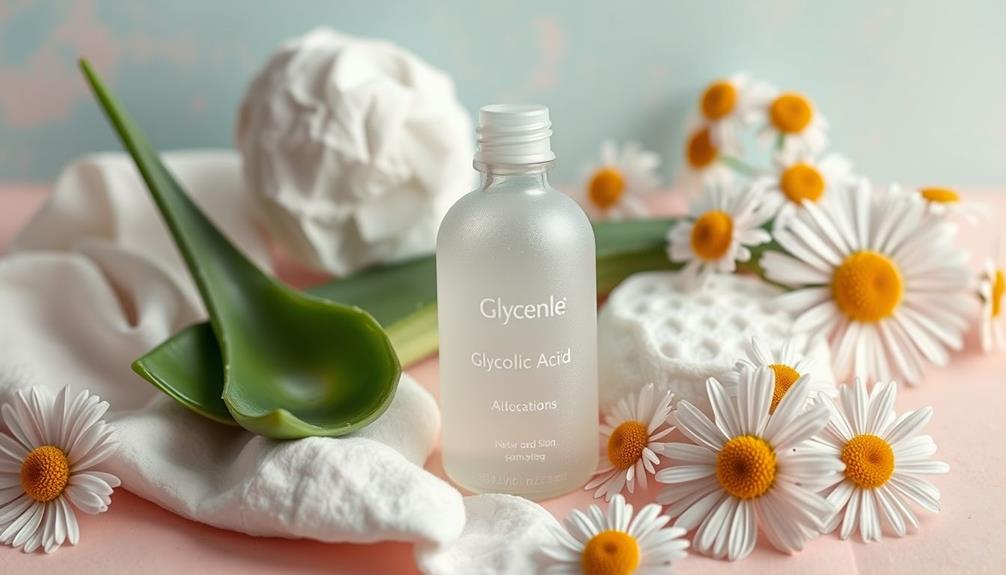
For those with sensitive skin, starting with lower concentrations of glycolic acid is key to gauging tolerance and minimizing irritation. Here are some essential precautions to take into account:
- Start Low: Use glycolic acid products with 5-8% concentration initially. This helps reduce the risk of irritation while allowing your skin to adjust.
- Patch Test: Always conduct a patch test before applying the product to your face. This can help detect any adverse reactions, such as redness or burning, before full use.
- Moisturizing: After using glycolic acid, follow up with a good moisturizer. This maintains your skin's barrier and hydration, preventing dryness and irritation.
- Sunscreen: Daily sunscreen application is vital when using glycolic acid. It increases your skin's sun sensitivity, making you more prone to hypopigmentation and other sun-related issues.
Professional Treatments Available
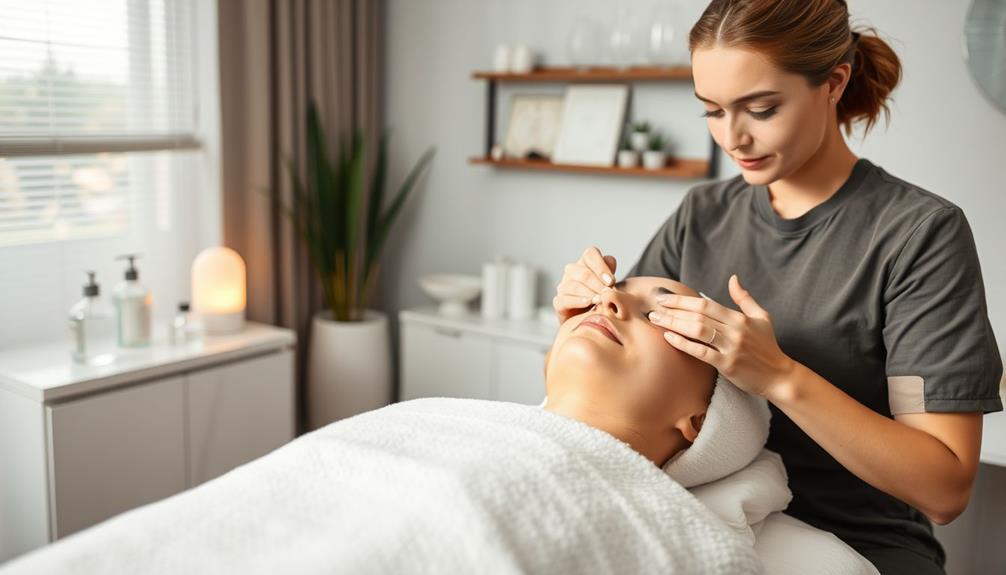
When considering professional treatments for acne, you'll find glycolic acid peels are a popular option.
These treatments, recommended by dermatologists, can considerably improve your skin's texture and reduce acne lesions.
Additionally, combining these peels with at-home products can help maintain your results and enhance your skin's overall health.
Chemical Peels Overview
Chemical peels with glycolic acid provide a powerful professional treatment option for acne, effectively promoting skin exfoliation and improving overall texture. When you opt for this treatment, you can expect several benefits:
- Exfoliation: Glycolic acid breaks down the bonds between dead skin cells, leading to smoother skin and fewer clogged pores.
- Reduction of Acne Lesions: Clinical studies show significant improvement in various acne lesions, including comedones, papules, and pustules.
- Multiple Sessions Needed: For ideal results, you'll likely need several sessions. This consistent treatment is essential for minimizing acne scars and rejuvenating your skin.
- Skincare Regimen: Post-peel, adhering to a strict skincare regimen is critical. Daily sunscreen application is fundamental to protect your newly treated skin from UV damage and prevent hyperpigmentation.
At-Home Treatment Options
At-home glycolic acid treatments offer a convenient way to manage acne while promoting smoother skin and improved texture. These products typically come in concentrations ranging from 5% to 15% and include lotions, creams, and serums designed for gentle exfoliation. Regular use can clear clogged pores, reduce inflammation, and enhance cell turnover.
To effectively incorporate glycolic acid into your routine, consider starting with lower concentrations, gradually increasing strength as your skin tolerates it. Here's a quick comparison of treatment options:
| Product Type | Concentration |
|---|---|
| Lotions/Creams | 5% – 10% |
| Serums | 10% – 15% |
| Maintenance | Alternating lower concentrations |
Daily sunscreen application is vital when using glycolic acid, as it can increase sensitivity and risk of irritation. By adhering to this regimen, you'll greatly enhance your acne management efforts while improving skin texture and overall appearance. Remember, consistency is key for achieving the best results with your at-home glycolic acid treatments.
Dermatologist Recommendations and Guidelines
For those seeking more intensive treatment options, dermatologists often recommend professional glycolic acid procedures to effectively target acne. These treatments can provide significant improvements, especially when combined with other acne medications. Here are some guidelines to take into account:
- Start with Lower Concentrations: For individuals with skin sensitivity, dermatologists typically suggest starting with glycolic acid concentrations of 5-8% to minimize irritation.
- Professional Treatments: Glycolic acid peels with concentrations ranging from 30-70% should only be performed by a licensed dermatologist to guarantee safety and effectiveness.
- Irritation Monitoring: It's important to monitor your skin's response during treatments. Dermatologists may recommend adjusting your regimen based on your skin's sensitivity and reaction.
- Follow-Up Consultations: Regular check-ins with your dermatologist are vital for evaluating treatment efficacy, making necessary adjustments, and guaranteeing the best acne management.
Clinical studies support the consistent use of glycolic acid in both professional and at-home settings, showing significant improvement in acne lesions. By adhering to these dermatologist recommendations, you can effectively enhance your acne treatment strategy while minimizing potential side effects.
Research Findings on Efficacy
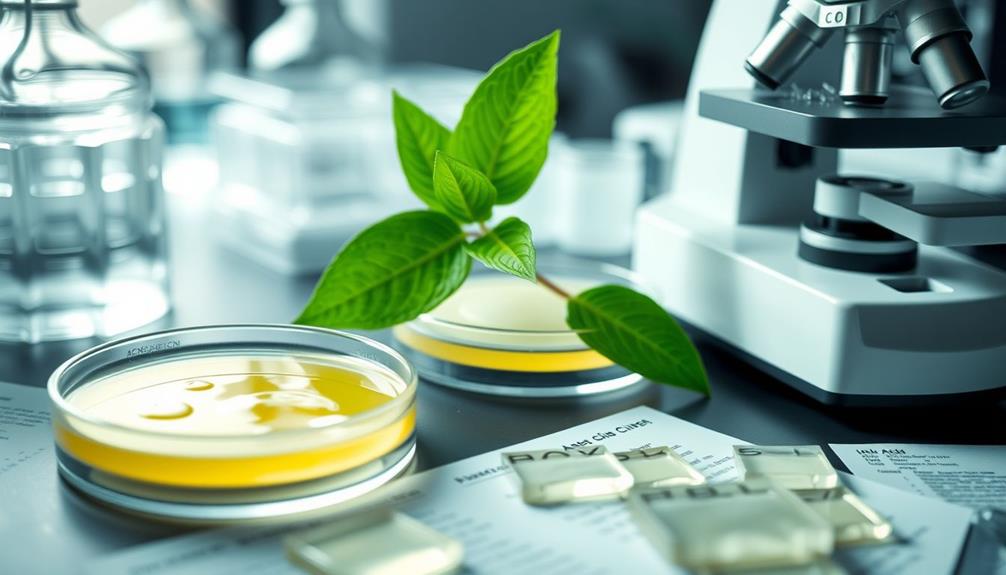
Recent studies have shown that glycolic acid peels can effectively reduce various types of acne lesions, making it a promising option for those struggling with skin issues.
In a study involving 40 participants with moderate to moderately severe acne, serial glycolic acid peels resulted in significant reductions in facial lesions, including comedones, papules, and pustules. Many participants noted substantial improvements in skin texture and a decrease in the size of follicular pores after using 35% and 50% glycolic acid peels combined with 15% glycolic acid home care products.
The research emphasizes the importance of consistent treatment, as repeated glycolic acid applications were necessary to achieve noticeable improvements in acne scars and cystic lesions.
Only 5.6% of participants reported minor side effects, which suggests a favorable safety profile for glycolic acid as an acne treatment. Overall, the findings support glycolic acid's efficacy as an effective adjunctive treatment for acne, especially for individuals with Asian skin types, thanks to its minimal side effects and significant therapeutic value.
If you're dealing with hormonal acne or other lesions, you might find glycolic acid to be a beneficial addition to your skincare routine.
Alternative Exfoliation Methods
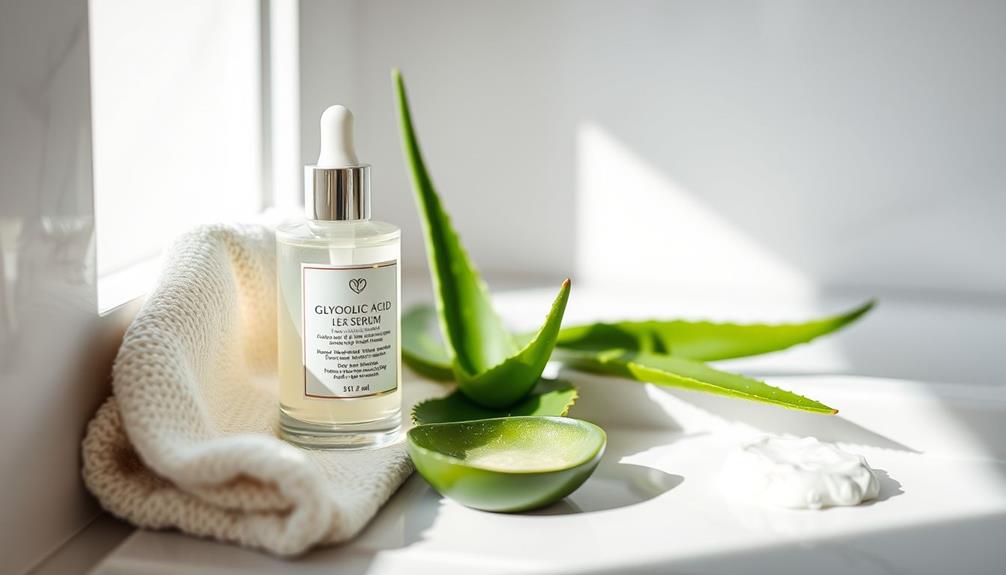
Alternative exfoliation methods offer various options for achieving smoother, clearer skin, catering to different skin types and concerns. While glycolic acid is a popular choice, you may want to explore other techniques that can also help with acne and improve skin texture. Here are four effective alternatives:
- Physical Exfoliants: Scrubs use abrasive particles to slough off dead skin cells. However, they may not penetrate as deeply as chemical exfoliants like glycolic acid.
- Enzyme Exfoliants: Derived from fruits like papaya or pineapple, these gentle options break down dead skin cells without causing irritation, making them ideal for sensitive skin types.
- Microneedling: When combined with glycolic acid peels, this technique can enhance product absorption and stimulate collagen production, helping to reduce acne scars and improve overall skin texture.
- Retinoids: Another class of chemical exfoliants, retinoids can effectively promote cell turnover for acne treatment, though they might cause more irritation compared to glycolic acid.
Frequently Asked Questions
How Does Glycolic Acid Help With Acne?
Glycolic acid helps with acne by exfoliating your skin, removing dead cells, and preventing clogged pores. It boosts cell turnover, enhances skin texture, and reduces inflammation, making it effective in managing breakouts and improving overall skin health.
Can You Put Glycolic Acid on a Popped Pimple?
Imagine you've just popped a pimple. You shouldn't apply glycolic acid immediately; wait for healing to begin. Start with a lower concentration to minimize irritation, and always follow with moisturizer and sunscreen for protection.
How to Use Glycolic Acid Toner for Acne?
To use glycolic acid toner for acne, apply a small amount to a cotton pad and swipe it over your cleansed skin. Start with a low concentration, and always follow up with a moisturizer and sunscreen.
How Does Glycolic Acid Unclog Pores?
Glycolic acid unclogs pores by breaking down the bonds between dead skin cells, promoting their shedding. It penetrates deeply, dissolving excess oil and debris, leading to smoother skin and preventing future blockages effectively.
Conclusion
Incorporating glycolic acid into your skincare routine can be like planting seeds in a garden; with patience and care, you'll see your skin flourish. Glycolic acid benefits include exfoliation, brightening, and reducing the appearance of fine lines and wrinkles. By using products containing glycolic acid regularly, you can help improve the texture and overall health of your skin. Just like tending to a garden, consistency is key to seeing the full potential of glycolic acid on your skin.
Research shows that 70% of users notice significant improvement in their acne after consistent use.
Just remember, like nurturing a garden, it's crucial to start slow and listen to your skin.
With the right approach, glycolic acid can help you achieve the clear, radiant complexion you've always wanted.


